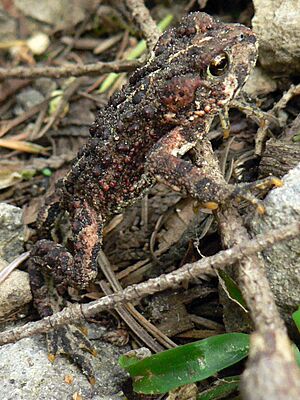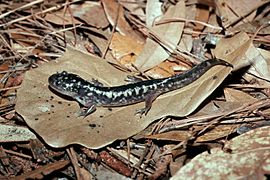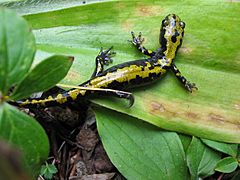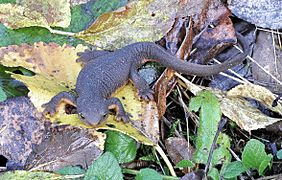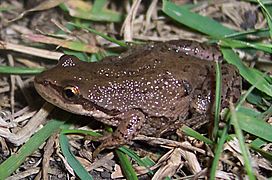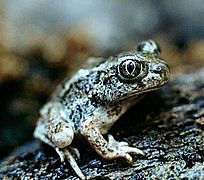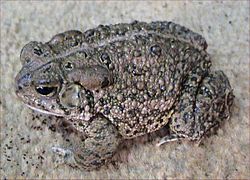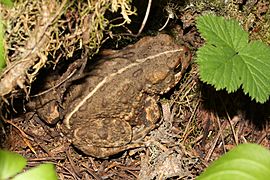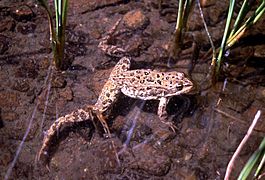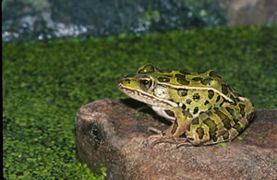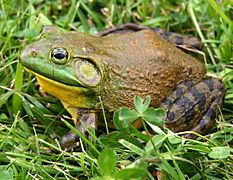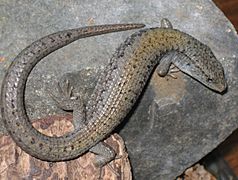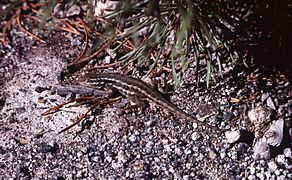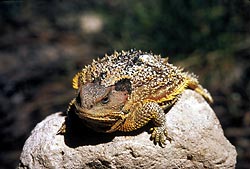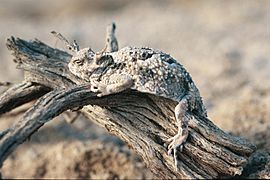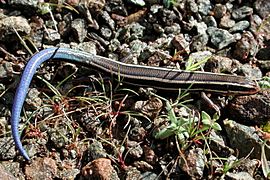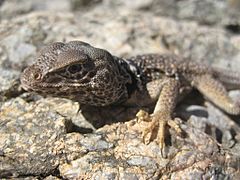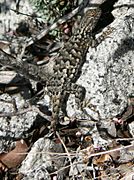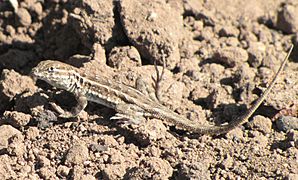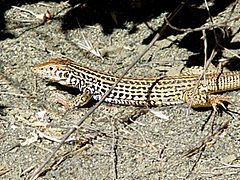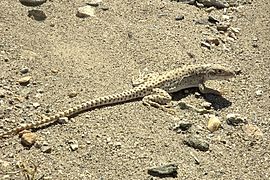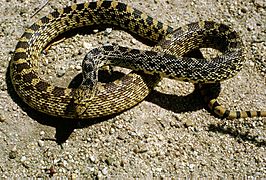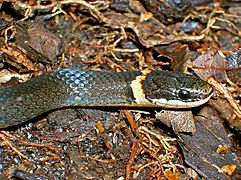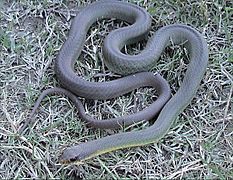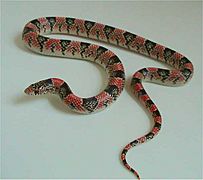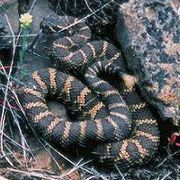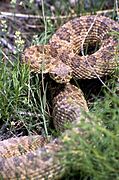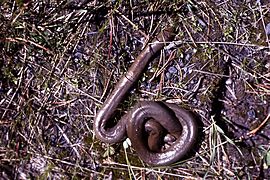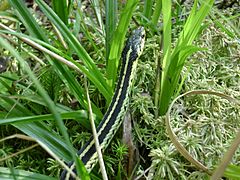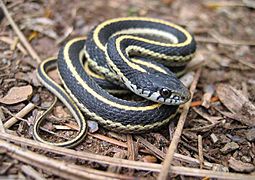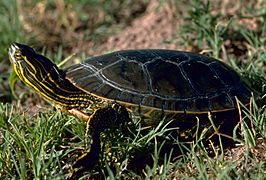List of amphibians and reptiles of Idaho facts for kids
Idaho is a cool place that's home to many different animals! You can find 15 types of amphibians and 22 kinds of reptiles here. Let's learn about some of them!
Contents
- Amphibians
- Reptiles
- Northern Alligator Lizard
- Mojave Black-Collared Lizard
- Long-Nosed Leopard Lizard
- Common Sagebrush Lizard
- Short-Horned Lizard
- Desert Horned Lizard
- Western Skink
- Western Fence Lizard
- Side-Blotched Lizard
- Western Whiptail
- Rubber Boa
- Eastern Racer
- Ringneck Snake
- Night Snake
- Striped Whipsnake
- Gophersnake
- Longnose Snake
- Ground Snake
- Common Garter Snake
- Terrestrial Garter Snake
- (Northern) Pacific Rattlesnake
- Prairie Rattlesnake
- Western Painted Turtle
Amphibians
Tiger Salamander
The tiger salamander is a big salamander, usually about 6 to 8 inches long. Some can even grow up to 14 inches! They often have blotchy patterns of gray, green, or black. They have large eyes, short snouts, and strong legs.
Tiger salamanders mostly eat small insects and worms. Sometimes, bigger ones might even eat small frogs or baby mice. In Idaho, you can find them in the eastern part of the state, the western panhandle, and some southwestern areas.
Long-toed Salamander
The long-toed salamander is a smaller salamander, usually 1.5 to 3.5 inches long. It has a cool mottled pattern of black, brown, and yellow. A special feature is its long fourth toe on its back feet!
These salamanders live in many different places, from wet forests to dry sagebrush plains. They like slow-moving streams, ponds, and lakes when they are breeding. During cold winters, they hibernate, which means they go into a deep sleep. In Idaho, they are the most common salamander and are found throughout the northern and central parts of the state.
Idaho Giant Salamander
The Idaho giant salamander is a large and strong salamander. It's usually dark brown, purple, tan, gray, or even a copper color, with cool blotchy patterns. They typically grow to about 8 inches long, but some can be around 13 inches.
These salamanders are predators. They have a thick head and body. You can find them in forested areas from Lake Coeur d'Alene all the way to the Salmon River in Idaho.
Coeur d'Alene Salamander
The Coeur d'Alene salamander is a type of woodland salamander. It's special because it doesn't have lungs! It breathes through its skin. Most of these salamanders live in northern Idaho. You might also find a few in western Montana and southeastern British Columbia.
Rough-skinned Newt
The rough-skinned newt is known for its strong poison, so it's best to look but not touch! These newts live along the West Coast of the United States and British Columbia. They are quite rare in Idaho. They have only been found in a few ponds near Moscow, Idaho, where they might have been brought by people.
Tailed Frog
Tailed frogs are unique because the male frog has a small "tail." This tail is actually part of its body that helps it reproduce. It's one of the only frogs in North America that reproduces this way! This special feature helps them live in fast-flowing streams.
There are two types: the coastal tailed frog and the Rocky Mountain tailed frog. In Idaho, you can find tailed frogs in the central and north-central forests where there are suitable streams.
Boreal Chorus Frog
The boreal chorus frog is a small frog, only about 1.2 inches long. It's usually brown, but can sometimes be green. It has three broken stripes on its back, which can be very clear or quite faint. It also has a dark stripe from its nose, through its eye, and down its side.
These frogs have slightly bigger toe pads to help them climb small plants. In Idaho, you can find them in the eastern part of the state and along the Snake River plain.
Pacific Tree Frog
The Pacific tree frog is a very common frog. It lives all along the West Coast, from California up to British Columbia. These frogs can live anywhere from sea level to over 10,000 feet high! They come in shades of green or brown and can even change colors.
They live in many different habitats and reproduce in water. In Idaho, you can find the Pacific tree frog across much of the western and northern parts of the state.
Great Basin Spadefoot Toad
The Great Basin spadefoot is a type of toad that lives in many different habitats. These include forests, shrublands, sagebrush plains, grasslands, and even deserts. They are also found in farm areas.
You can find them from southern British Columbia, through eastern Washington and Oregon, and into southern Idaho. Their range also covers Nevada and most of Utah. In Idaho, they live in the deserts and prairies of the southern part of the state.
Western Toad
The western toad is a large toad, usually between 2 and 5 inches long. It has a white or cream stripe down its back. Its skin is often dusky gray or greenish with dark blotches.
These toads are very common in Idaho. You can find them in suitable habitats throughout most of the state.
Woodhouse's Toad
Woodhouse's toad is a medium-sized true toad, about 4 inches long. It's native to the United States and Mexico. These toads sometimes mix with other toad species where their homes overlap.
In Idaho, Woodhouse's toads live in the western part of the state. They are especially found along the Snake River and the streams that flow into it.
American Bullfrog
The American bullfrog is a large aquatic frog. It's a member of the "true frog" family and is native to much of North America. These frogs love big, permanent bodies of water like swamps, ponds, and lakes. You'll usually find them right at the water's edge.
On rainy nights, bullfrogs often travel over land. In Idaho, bullfrogs are found in the Snake River Plain in the western part of the state and in the western part of the panhandle.
Columbia Spotted Frog
The Columbia spotted frog is a medium-sized frog, growing up to about 3.5 inches long. Its color can be dark olive green to light brown. It has black spots that are shaped unevenly on its back and legs, which gives it its name! Its belly and upper lip are white.
You can tell them apart from other frogs by their shorter back legs, narrow snout, and eyes that point upwards. They also have more webbing on their back feet because they spend a lot of time in the water. In Idaho, they are found in much of the northern part of the state and some isolated spots in southwestern Idaho.
Northern Leopard Frog
The northern leopard frog is a fairly large frog, reaching about 4 inches long. It can be green or brown on its back. It has big, dark, circular spots on its back, sides, and legs.
These frogs live in many different places, like ponds, swamps, and slow-moving streams. They like water bodies with lots of plants. They can handle cold weather and are found high up in mountains. Some populations faced challenges in the past, but many are still recovering. In Idaho, they are found in much of the southern part of the state along the Snake River plain. You can also find them in the northern panhandle.
Wood Frog
The wood frog lives in many parts of North America. It's known for its ability to survive freezing temperatures by producing a natural antifreeze in its body. In Idaho, wood frogs are only found in Boundary and Bonner counties, which are in the very northern part of the state.
Reptiles
Northern Alligator Lizard
The northern alligator lizard is a medium-sized, slender lizard. Adults are about 4 inches long from snout to vent, and their total length can be around 10 inches. They have rough scales on their back and smooth scales on their belly.
These lizards are brownish and often have dark blotches that can look like bands. Their belly is light gray, and their eyes are dark. They might bite if they feel threatened. You can find them in northern Idaho, as well as along the Pacific Coast and in the Rocky Mountains.
Mojave Black-Collared Lizard
The Great Basin collared lizard is also called the Mojave black-collared lizard. It looks a lot like the common collared lizard but doesn't have as many bright colors. Males can be brown to orange, sometimes with red or pink on their belly. Females are usually darker, like black or dark brown.
These lizards need outside energy, like sunlight, to warm up their bodies. In Idaho, you can find them in the southwestern part of the state, along the Snake River Plain and the nearby Owyhee foothills.
Long-Nosed Leopard Lizard
The long-nosed leopard lizard is a fairly large lizard, usually 3 to 5.75 inches long. It has a big head, a long nose, and a long, round tail that can be longer than its body!
These lizards are closely related to the blunt-nosed leopard lizard. The name wislizenii honors a German-American surgeon and naturalist named Frederick Adolph Wislizenus. In Idaho, you can find the long-nosed leopard lizard in suitable habitats across much of the southern part of the state.
Common Sagebrush Lizard
The sagebrush lizard is a common lizard found in the western United States. It's named after the sagebrush plants where it's often found. This lizard has rough, spiny scales along its back.
In Idaho, you can find sagebrush lizards in suitable habitats across most of the southern part of the state.
Short-Horned Lizard
The pygmy short-horned lizard is a small lizard. People sometimes wrongly call it a "horned toad," but it's a reptile, not an amphibian! Like other horned lizards, it has small horns on its head.
In Idaho, you can mostly find the pygmy short-horned lizard in southern Idaho. There are also old records of them in northwestern Idaho.
Desert Horned Lizard
The desert horned lizard is another lizard often called a "horned toad," even though it's not a toad! They typically live from southern Idaho down to northern Mexico.
There are two main types: the northern desert horned lizard, found in Idaho, Wyoming, Utah, and Nevada; and the southern desert horned lizard. In Idaho, desert horned lizards are only found in the southwestern part of the state.
Western Skink
The western skink is a small, smooth-scaled lizard, usually about 4 to 8 inches long. They have small legs. Western skinks are very good at adapting to different places. They spend much of their day basking in the sun to warm up.
Their diet includes many things, like spiders and beetles. If you try to grab them, they might bite, and they will run away if they feel scared. In Idaho, western skinks are found across much of the state, except for the very southwestern and southeastern corners.
Western Fence Lizard
The western fence lizard is a common lizard in California and nearby areas. It's also called the blue-belly because adult males have a blue belly! Young lizards have aquamarine-colored bellies.
This lizard is a type of spiny lizard. While California is where most of them live, you can also find them in southwest Idaho, Nevada, and Utah. They live in many different places, like grasslands, forests, and farms. In Idaho, western fence lizards are found across the lower, western half of the state.
Side-Blotched Lizard
The common side-blotched lizard is common on the Pacific coast of North America. It has a unique way of finding mates, almost like a game of "rock, paper, scissors" with three types of males!
The name stansburiana honors Captain Howard Stansbury, who collected the first lizards during an expedition in Utah. In Idaho, side-blotched lizards live in the southwestern part of the state.
Western Whiptail
The western whiptail is a small lizard, usually about 10 to 14 inches long. It lives throughout most of the southwestern United States. These lizards live in many different habitats, including deserts and shrublands, usually where there isn't much plant growth. They also live in woodlands and dry forests.
They live in burrows underground. Since they don't move far, different types have developed in different regions. In Idaho, western whiptails are only found in the southwestern section of the state.
Rubber Boa
The rubber boa is a non-venomous snake. It's part of the boa family, which includes 43 different species! The rubber boa is one of four species in its group, with three found in North America.
In Idaho, rubber boas can be found in many different places, from desert shrub areas to open pine forests. They often like to be near water and use rocks, wood, or leaves for cover. Rubber boas are found all over the state!
Eastern Racer
The eastern racer is a non-venomous snake. They are mostly found throughout the United States, east of the Rocky Mountains, but also in Canada and Mexico. Racers usually grow to about 3.5 feet long, but some can reach 6 feet!
Their patterns can vary a lot, but most are solid colored, like black, brown, blue, or green. In Idaho, the eastern racer is found across most of the state, but not in the very northern part.
Ringneck Snake
The ringneck snake is a secretive snake that is rarely seen during the day. It's found in much of the United States, central Mexico, and southeastern Canada. They are slightly venomous, but they are not aggressive and their small fangs are not a threat to humans.
They are best known for their cool defense move: when scared, they curl up their tail to show off their bright red-orange underside! In Idaho, ringneck snakes are found in three separate areas: the northwest, southwest, and southeast parts of the state.
Night Snake
The night snake is a type of snake with fangs in the back of its mouth. They are found in the southern and western United States, as well as Mexico. Not much is known about how many night snakes there are or their exact range because they are very good at hiding.
In Idaho, night snakes are found in the southern part of the state and northward along the Snake River to Lewiston.
Striped Whipsnake
The striped whipsnake is a non-venomous snake. It's closely related to the California whipsnake. It lives in the western United States and northern Mexico.
You can find the striped whipsnake all over the western United States. In Idaho, striped whipsnakes are found in the southwest and south-central parts of the state.
Gophersnake
The gopher snake is a harmless snake found in North America. They can be found in many different places, from desert shrublands to low mountain areas. Like the racer, gopher snakes are often found in farm areas because there's lots of food for them there.
In Idaho, gopher snakes can be found in suitable habitats across most of the state, except for the northern part.
Longnose Snake
The long-nosed snake is a non-venomous snake. It's the only species in its group, but it has four different types! Its name honors John Eatton Le Conte.
Long-nosed snakes live in dry, often rocky, grassland areas of northern Mexico and the southwestern United States. In Idaho, long-nosed snakes are found in the southwestern desert regions of the state. They might also be found south of Burley.
Ground Snake
The western ground snake is a small, harmless snake. It's sometimes called the variable ground snake because its patterns and colors can change a lot, even in the same area! It's native to the southwestern United States and northern Mexico.
In Idaho, western ground snakes are found in the southwestern part of the state, along the Snake River and the streams that flow into it.
Common Garter Snake
The common garter snake is a snake native to North America. Most garter snakes have yellow stripes on a brown background. They are usually about 3 to 5 feet long.
The common garter snake is active during the day. In summer, it's most active in the morning and late afternoon. In cooler weather, it's active during the warm afternoons. In Idaho, the common garter snake is found in the north, north-central, and southeast parts of the state.
Terrestrial Garter Snake
The terrestrial garter snake lives in southwestern Canada and the western United States. Most of these snakes have a yellow, light orange, or white stripe down their back, with two more stripes of the same color on their sides. Some even have red or black spots between the stripes!
This snake often lives in pine forests and likes to be near water. In Idaho, terrestrial garter snakes can be found all over the state.
(Northern) Pacific Rattlesnake
The northern Pacific rattlesnake lives in the southern and western parts of Idaho. The Great Basin rattler is a type of this rattlesnake found in the southern parts of the state. Remember, rattlesnakes are venomous, so it's important to stay away from them and never try to touch them.
Prairie Rattlesnake
The prairie rattlesnake is a venomous snake. It's native to the western United States, southwestern Canada, and northern Mexico. Like all rattlesnakes, they have a rattle on their tail that they shake to warn you.
In Idaho, prairie rattlesnakes are found in all but the very northern part of the state, and they don't live in very high mountain areas. Always be careful and give them space!
Western Painted Turtle
The painted turtle is the most common native turtle in North America. It lives in slow-moving fresh waters, from southern Canada down to Louisiana and northern Mexico, and from the Atlantic to the Pacific Ocean.
In Idaho, painted turtles can be found in the northern part of the state. They have also been seen in western Idaho in waters near the Payette and Boise Rivers, and in eastern Idaho near St. Anthony.


